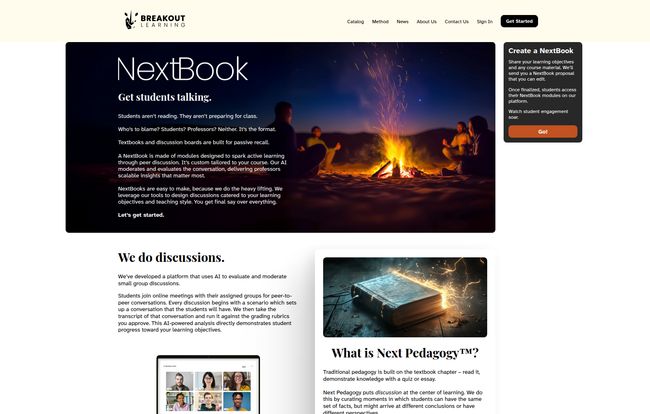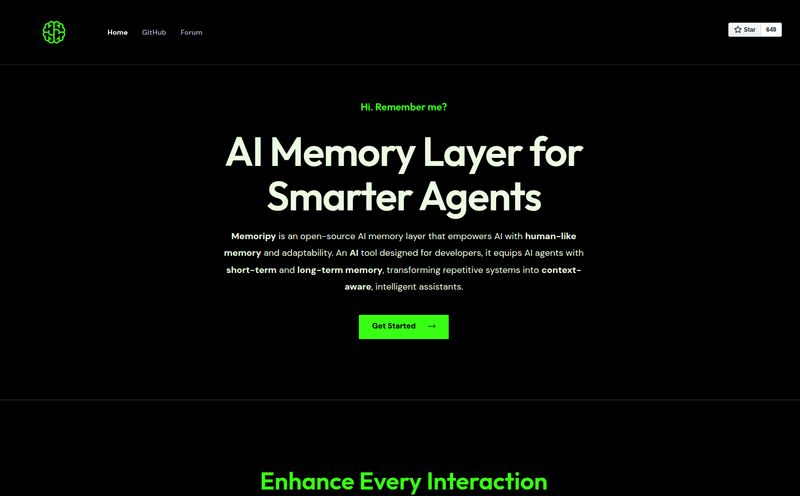We've all been there. You've just delivered what you thought was a killer lecture. You pose a thoughtful, open-ended question to your class, ready for a vibrant discussion to erupt. And then... silence. Just the gentle hum of the projector and the sound of crickets. Or worse, you put students into breakout rooms, and when you pop in, they're just staring at each other on mute.
For years, managing small-group discussions has felt a bit like herding cats. It's incredibly valuable for learning, but it's a beast to manage and almost impossible to grade fairly. Who's actually contributing? Is one student dominating the conversation while another is just along for the ride? As an educator, you can't be in all ten breakout rooms at once.
It’s a problem I've seen debated endlessly on forums and in faculty lounges. Well, a platform called Breakout Learning has swaggered onto the scene, claiming it can fix this. And honestly, I was skeptical at first. An AI to manage discussions? Sounds a little... robotic. But after digging in, I’m starting to think they're really onto something.
So, What Exactly is Breakout Learning?
Think of Breakout Learning as an AI-powered teaching assistant that you can clone and place in every single small-group discussion. Their whole system is built around a concept they call a Nextbook. Now, don't get hung up on the name; it’s not a physical book or an e-reader. A Nextbook is essentially a discussion module that you, the educator, build around a specific piece of source material. This could be a chapter from a textbook, a historical document like the Magna Carta, a case study, or even a scene from a film.

Visit Breakout Learning
The platform then uses its AI to guide students through peer-led conversations about that material. It prompts them, ensures everyone gets a chance to speak, and tracks the quality and equity of the discussion. The goal is to get students talking to each other and building understanding collaboratively, instead of just passively receiving information. It's a fundamental shift from the old 'sage on the stage' model to a more modern 'guide on the side' approach.
How Does This Whole AI Discussion Thing Work?
Okay, the 'AI TA' analogy is cool, but how does it work in practice? It's surprisingly straightforward.
- You Provide the Content: You start with your source material. Let's say you're teaching To Kill a Mockingbird and you want students to discuss the theme of justice in Chapter 10. You feed that context to the platform.
- You Customize the Module: You then set up your Nextbook, defining the key questions and learning objectives. This is where you can tailor the experience to your specific course goals. It’s not a canned, one-size-fits-all lesson plan.
- Students Break Out and Discuss: Students are placed in small groups (this works for both synchronous and asynchronous classes, a huge plus in our hybrid world). The AI acts as a moderator, gently nudging the conversation, posing follow-up questions, and encouraging quieter students to contribute.
- You Get the Insights: This is the magic part for educators. Instead of having to guess who participated, you get a dashboard full of analytics. You can see participation metrics, summaries of the discussions, and even get insights into student comprehension, all without having to sit in on every single group. It’s the scalable visibility we've always wanted.
The Features That Actually Matter to Educators
A lot of EdTech tools are packed with features that look great in a demo but are useless in a real classroom. Breakout Learning seems to have focused on things that genuinely solve problems. The AI moderation is the star of the show, of course. It's designed to foster Socratic dialogue, not just a simple Q&A. It promotes balanced, equitable conversations, which is a massive win for creating an inclusive learning environment.
The customizable modules are another big deal. You're not locked into a pre-made curriculum. You can adapt it to any subject, from business ethics to renaissance art. This flexibility is critical because no two classes are the same.
But for me, the most significant feature is the analytics and reporting. The amount of time educators spend trying to grade 'participation' is staggering, and it's often based on gut feelings. Breakout Learning attempts to turn that art into a science. Seeing who is substantively engaging with the material allows for a much more authentic and fair assessment of a student's contribution. This saves an incredible amount of time and mental energy.
The Good, The Bad, and The AI-Powered
What I Really Like About Breakout Learning
The biggest pro is the one they shout from the rooftops: it saves time while improving learning outcomes. By automating the moderation and evaluation of group work, it frees up professors to focus on higher-level tasks, like providing targeted feedback or planning the next big-picture lesson. It also makes peer-led learning scalable. You can provide a high-quality, small-group experience even in a lecture hall with 200 students. That’s a game-changer. And I have to say, anything that gets students to move beyond rote memorization and toward genuine critical thinking gets a gold star in my book.
Some Things to Keep in Mind
Now, it's not a perfect utopia. There are a few things to consider. First, the platform requires you to provide the source material and set up the discussion modules. It’s not a content library; it’s a tool. So there is some initial setup and a bit of a learning curve involved. You need to invest some time upfront to get the most out of it.
And let's address the elephant in the room: the reliance on AI. Some educators might worry that this reduces direct human interaction. I get it. The fear of AI 'replacing' teachers is a hot topic. In my experience, thats the wrong way to look at it. This isn't about replacement; it's about augmentation. The AI handles the logistical nightmare of moderation so the human educator can engage with the students and the insights more meaningfully. The professor is still the intellectual architect of the course, Breakout Learning is just the super-intelligent foreman.
What's the Damage? A Look at Pricing
Here's the million-dollar question. I scoured their website, but you won't find a neat little pricing table with three tiers. This is pretty standard for EdTech and B2B SaaS platforms. Pricing is almost certainly customized based on the institution's size, the number of students, and the level of support required.
Your best bet is to use the "Let's Talk" or "Speak with our team" button on their site to schedule a demo. This is usually a good thing, as it means you can have a conversation about your specific needs rather than trying to fit into a pre-defined box. Be prepared to discuss your use case, and they'll likely put together a custom quote for you or your institution.
My Final Take: Is Breakout Learning Worth It?
After looking at everything, I’m genuinely excited by the potential here. Breakout Learning isn't just another tool; it represents a pedagogical shift. It's built for educators who believe that learning is a conversation, not a monologue. It addresses a real, persistent pain point in a clever and scalable way.
If you're an educator who feels like you're constantly fighting for engagement, or if you're buried under the administrative weight of managing group work, you should absolutely request a demo. It might just be the AI teaching assistant you've been dreaming of.
Frequently Asked Questions
- Is Breakout Learning just for university classes?
- While it seems heavily geared towards higher education (universities, business schools), its principles could easily apply to advanced high school courses, like AP or IB classes, where deep discussion of source material is key.
- Does the AI completely replace the teacher in discussions?
- Not at all. The AI acts as a moderator and facilitator, not the source of knowledge. The teacher sets up the entire module, defines the goals, and uses the AI's insights to inform their teaching. Think of it as a tool to augment the teacher's abilities, not replace them.
- What kind of materials can I use with Breakout Learning?
- You can use a wide variety of materials. The examples on their site include historical texts, literary works, and case studies. Essentially, any source material that can fuel a rich discussion is a good candidate.
- How does Breakout Learning ensure fair participation?
- The AI moderator is programmed to promote equitable participation. It can gently prompt students who haven't spoken, manage turn-taking, and ensure that one or two voices don't dominate the entire conversation. The analytics also show the educator exactly who contributed and how much.
- Is it difficult to set up a "Nextbook" module?
- There is an initial setup process and likely a learning curve, as with any new powerful tool. You need to provide the source material and customize the discussion prompts. However, the time saved on moderation and grading down the line is designed to make that initial investment worthwhile.
- Can I use this for both online and in-person classes?
- Yes. The platform supports both synchronous (live) and asynchronous (on-demand) learning environments, making it very flexible for online, hybrid, or traditional face-to-face courses that use a digital component.
Conclusion
The classroom is changing, and the tools we use have to change with it. Moving beyond passive lectures to active, engaging, and measurable discussions is a challenge, but it's where the most profound learning happens. Platforms like Breakout Learning are at the forefront of this shift, using technology not as a gimmick, but as a genuine solution to a decades-old problem. It might just be the key to finally ending the sound of crickets for good.
Reference and Sources
- Breakout Learning Official Website: https://www.breakoutlearning.com/



